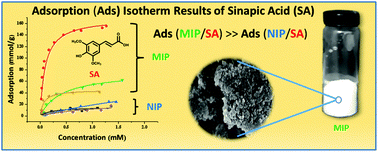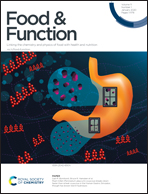Molecular imprinted polymers for the controlled uptake of sinapic acid from aqueous media†
Abstract
Several unique molecularly imprinted polymers (MIPs) were synthesized via a precipitation polymerization technique using 4-vinylpyridine as a functional monomer and ethylene glycol dimethacrylate as a cross-linker for selective separation of sinapic acid from aqueous solution. Three sets of MIPs with different functional monomer : cross-linker molar ratios at 4 : 20; 8 : 20 and 8 : 32 were prepared along with the corresponding non-templated polymers (NIPs). The MIPs and NIPs were characterized by scanning electron microscopy, dynamic light scattering, N2 adsorption analysis, thermogravimetry, and FT-IR/solids 13C NMR spectroscopy. Batch rebinding and selectivity experiments were carried out to evaluate their adsorption performance, where the MIP prepared with a 4 : 20 monomer : cross-linker mole ratio had significantly higher affinity toward sinapic acid. Notably, all MIPs displayed greater molecular recognition with sinapic acid relative to the NIPs. Therefore, MIPs prepared by this approach represent promising advanced materials for the pre-concentration, isolation and enrichment of sinapic acid from complex food matrices or controlled removal from agricultural waste streams.



 Please wait while we load your content...
Please wait while we load your content...